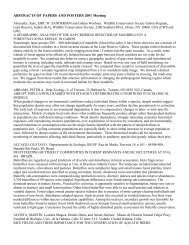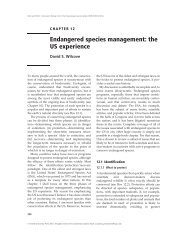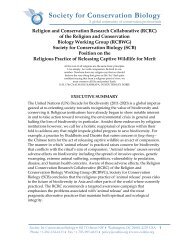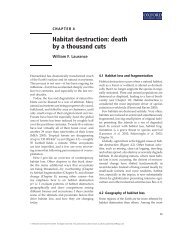ICCB 2013 Program - Society for Conservation Biology
ICCB 2013 Program - Society for Conservation Biology
ICCB 2013 Program - Society for Conservation Biology
You also want an ePaper? Increase the reach of your titles
YUMPU automatically turns print PDFs into web optimized ePapers that Google loves.
Symposium: Roadless and Low Density-Transportation Networks as Permeable Landscapes<br />
and Seascapes. Session I<br />
Room 307<br />
Tuesday, July 23, 08:00 to 10:00<br />
Organizer(s): Dominick DellaSala, Geos Institute<br />
Tuesday<br />
A vast network of roads and marine highways crisscrosses the planet, transporting people and goods over global distances with<br />
substantial environmental impacts. For instance, the ecological footprint of roads is known to extend up to a kilometer on<br />
either side of an individual road (road effect zone) with cumulative effects of dense road networks in some regions impacting<br />
up to 15-20% of total surface area (e.g., continental USA). Marine transportation networks and associated ship transport<br />
lanes also create migration and other problems <strong>for</strong> wildlife, including acoustic pollution and collision-related mortality.<br />
In contrast, areas with low road densities and/or low-traffic volume (marine and terrestrial) and those with no roads (e.g.,<br />
roadless areas in the USA, South America, Asia, Africa) are a conservation priority globally because they provide habitat <strong>for</strong><br />
road-adverse wildlife, have characteristic ecological processes, are relatively resistant to weed invasions, act as strongholds <strong>for</strong><br />
aquatic species, and provide climatic refugia. In some terrestrial regions (e.g., western Europe), only low-density roads with<br />
low traffic volume remain and these areas are building blocks <strong>for</strong> re-wilding landscapes. This symposium will provide a global<br />
synthesis of impacts of vast transportation networks and a region by region and a global synthesis on the importance of intact<br />
areas showcasing new intactness and human footprint technologies.<br />
08:00 The netway system: recovering lost ground, reconnecting the land, and solving big transportation problems<br />
Richard Forman, Harvard University<br />
08:15 Roadless areas as a way to protect biodiversity<br />
Kriton Arsensis, European Parliment member<br />
08:30 Global human-fingerprint project: an overview<br />
Eric Sanderson, Wildlife <strong>Conservation</strong> <strong>Society</strong><br />
08:45 Global human-fingerprint project: an update<br />
Oscar Venter, James Cook University<br />
09:00 Google’s mapping of roadless areas of the Earth<br />
Rebecca Moore, Google Earth<br />
09:15 Roadless and low-traffic areas in Europe. Rewilding European landscapes <strong>for</strong> permeability<br />
Nuria Selva, Policy Academy of Sciences<br />
09:30 North America’s roadless area network<br />
Dominick DellaSala, Geos Institute, SCB North America<br />
09:45 Latin America and Caribbean roadless area network<br />
Mariana Vale, Departamento de Ecologia Universida<br />
...............................................<br />
Symposium: Still ‘Shooting in the Dark’ Policy Insights from the Frontiers of Evidencebased<br />
<strong>Conservation</strong>: Session I<br />
Room 308<br />
Tuesday, July 23, 08:00 to 10:00<br />
Organizer(s): Louise Glew, World Wildlife Fund; Michael B. Mascia, World Wildlife Fund<br />
Evidence-based policy and practice has emerged as a major focus of biodiversity conservation research in the past decade.<br />
Scholars and practitioners increasingly recognize that without empirical evidence, decisions on where and how to conserve<br />
biodiversity constitute a ‘shot in the dark’. The nascent evidence base emerging from quasi-experimental impact evaluation,<br />
which allows scholars to make causal inferences about the ecological and social impacts of conservation interventions, has<br />
generated important insights <strong>for</strong> conservation practice and overturned long-held conventional wisdom. The evidence derived<br />
from these pioneering impact evaluation studies remains limited in scope, however, with considerable mismatch between the<br />
insights generated and the needs of policymakers. Addressing this disparity requires future generations of evaluative studies to<br />
advance six methodological ‘frontiers’: diversifying the range of outcome metrics; documenting variation in impact; linking<br />
interventions to impact; exploring trade-offs and synergies between outcomes; comparing the effectiveness of interventions;<br />
and translating evidence into policy and practice. This session brings together scholars and practitioners to explore these six<br />
frontiers across a range of interventions, biomes and sociopolitical contexts to highlight the potential and the limits of impact<br />
evaluation in conservation, in order to catalyze policy-relevant research and further advance conservation policy.<br />
08:00 It’s tough to learn in the dark<br />
Kent Red<strong>for</strong>d, Archipelago Consulting<br />
94






